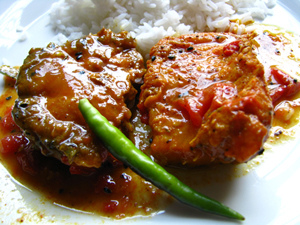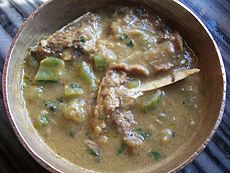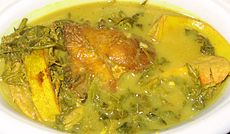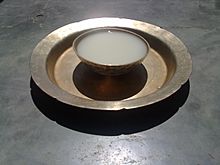Assamese cuisine facts for kids
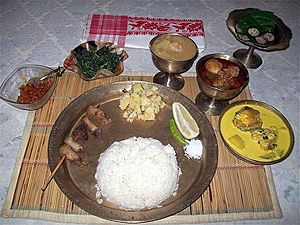
Assamese cuisine is the traditional food from the Indian state of Assam. It's a mix of cooking styles from the hills and plains. People in the hills often preserve food by fermenting or drying it. In the plains, there are lots of fresh vegetables, fish, and meat. Both styles focus on rice as the main food.
Assamese cooking is unique. It uses very few spices and isn't cooked over high heat for long. The flavors are strong because of special local fruits and vegetables. These can be fresh, dried, or fermented. Fish is very popular. Birds like duck, pigeon, and squab are also common. They are often cooked with a main vegetable.
Traditional meals usually start with a dish called khar. This dish gets its name from its main ingredient. Another common dish is tenga, which is a sour dish. People usually don't eat khar and tenga in the same meal. Food is often served in special bell metal dishes. These are made by a local community called Mariya. Meals often finish with tamul (betel nut) and paan.
This cuisine is becoming more well-known. People are starting to discover its unique flavors and traditions.
Contents
- What's in Assamese Food?
- Special Dishes
- Khar: The Unique Start
- Masor Tenga: Sour Fish Curry
- Naraxingho Masor Jul: Curry Leaf Fish
- Pura: Grilled and Roasted Foods
- Poitabhat: Cool Rice for Summer
- Pitika: Delicious Mashes
- Pickles: Tangy Sides
- Chutney and Salad: Fresh Flavors
- Bor: Fried Balls
- Fritters: Crispy Treats
- Other Special Dishes
- Traditional Drinks
- Snacks and Cakes
- Tamul: The Meal Ender
- See Also
What's in Assamese Food?
Rice: The Main Star
Rice is super important in Assamese cooking. There are many types of rice grown here. Some people think rice was first grown in the Assam-Yunnan area. Both indica and japonica types of rice grow in Assam. The most popular kind is joha, which is scented rice.
People eat rice in many ways. It can be steam boiled (ukhua) or sundried (aaroi). Some very fine rice types, like Karaballam, are only found in Assam.
Rice is also eaten as a snack. It can be roasted and ground (xandoh), or boiled and flattened (chira). Kumol saul is rice that's partly cooked and dried. You can just soak it in warm water for a quick meal.
A traditional breakfast might be chira with yogurt and jaggery. Farmers often eat cooked rice soaked overnight (poita). They add just salt, mustard oil, and onions. Sticky rice (bora saul) is eaten with sweet or salty things.
For bigger meals, rice can be boiled or steamed. Sometimes it's wrapped in leaves and roasted. 'Sunga Saul' is sticky rice cooked inside bamboo tubes. 'Sewa diya Bhaat' is sticky rice steamed over boiling water. These are often served with meat or fish.
Special rice cakes called pithas are made for special events like the Bihu festival. They are usually made from soaked and ground sticky rice. They can be fried, roasted in bamboo, or baked and rolled with a filling.
Fish: A Favorite Dish
Fish is the next most important food. It comes from the many rivers, ponds, and lakes in Assam. Because it rains a lot, there are many kinds of fresh water fish. Almost everyone in Assam eats fish. Many families have their own ponds to raise fish.
Some popular big fish are Borali, rou, and cital. Smaller fish include puthi (Swamp barb), Ari, and Koi. People who know a lot about food can tell which part of Assam is famous for which fish.
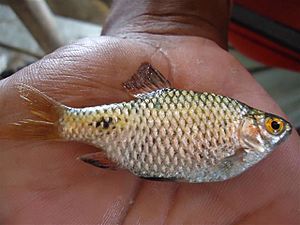
Mas tenga (sour fish) is a very famous Assamese dish. It's made sour with tomatoes, kajinemu (a type of lemon), or thekera (dried mangosteen). Other souring agents include Ou-tenga and Tengamora (Roselle leaves).
Fish is often cooked as a stew with herbs and vegetables. It can also be roasted or grilled. A popular dish is small fish roasted in banana leaves (paatotdia). Hukoti is a special dish made from dried small fish pounded with arum stem. Fish eggs and insides are also cooked. Petu bhoja (fried fish insides) is a special treat. There's also Jal, an herbal fish curry with medicinal herbs.
- See also Fish of Assam
Meat: A Variety of Choices
Assamese meat dishes use few spices and less oil. They use more ginger, noroxinghow paat (curry leaves), Khorisa (fermented bamboo shoot), and lemon juice. This makes them taste very different from dishes in Bengal. They are more like foods from South-East Asian countries.
Chicken, squab, Mutton, Duck, and Pork are popular among many local communities. Some communities do not eat pork. Some people eat beef. Many people eat all types of meat.
Meat is usually cooked by stewing, shallow frying, or deep frying. Onla, a dish from the Bodos, is made with ground rice and special herbs. It's a full meal by itself.
Popular combinations include duck with white gourd, or squab with papaya or banana flower. Meat is generally stewed with limited spices and a choice of herbs and vegetables.
Many communities in Assam also eat insects. They eat silkworms, water bugs, and grasshoppers. Insects are fried, cooked, or roasted in leaves. Red ant eggs (amroli poruar tup) are a special treat during the Rongali Bihu festival.
Green Vegetables: Healthy Greens
Assam has lots of plants, so green leafy vegetables, called xaak, are a big part of the food. Some are grown, while others like dhekia (fern) grow wild. There are so many kinds! People say you should eat 101 different xaak during Rongali Bihu.
Herbs, greens, and vegetables are often cooked simply with water and salt. They can also be lightly fried, made into a thick soup, or added to lentils. They are also cooked with fish, meat, and eggs.
Spices of Assam: Unique Flavors
Assamese cooking uses spices like ginger, garlic, onion, cumin seed, black cumin, black pepper, chilli, turmeric, and coriander seed. Other spices include cinnamon, cardamom, clove, and fenugreek seed.
Some herbs are special to Assam. These include maan dhaniya, moran Ada, madhuhuleng, bhedai lota, manimuni, masundari, tengesi, thekera, kordoi, outenga, and tengamora.
A meal in Assam isn't complete without green chilis. Assam is famous for the bhut jolokia, once known as the hottest chili in the world! Panch-furan (a mix of 5 spices) is used to flavor Dail (lentils).
Special Dishes
Khar: The Unique Start
Khar is a special type of dish. It's named after its main ingredient, also called khar. This traditional ingredient is made by filtering water through the ashes of sun-dried banana skins. This is called kola khar.
A traditional meal always starts with a khar dish. It can be made with raw papaya, mustard leaves, vegetables, pulses, or fish.
Xôkôta is a very bitter khar dish. It's made with dry jute leaf, urad bean, and khar. It's usually not recommended to eat khar (alkaline) and tenga (acidic) dishes together. The liquid khar can also be eaten simply as kharoli with rice, by adding a few drops of mustard oil.
Assamese people enjoy many bitter dishes. Some examples are fresh bamboo shoot, cane shoot, Neem leaves, bitter gourd, and Sewali Phool.
Masor Tenga: Sour Fish Curry
Masor tenga is a light and sour fish dish. It's another very famous Assamese food. There are many ways to make this sour fish curry. The sour taste can come from mangosteen, lemon, tomatoes, roselle leaves, Outenga, or Manimuni.
Fish cooked with fermented bamboo shoot (khorisa) is also sour, but it's not called tenga. Fish can be fried in mustard oil or stewed with bottle gourd or spinach. Another tenga dish is made with matimah (urad bean) and outenga (elephant apple).
Naraxingho Masor Jul: Curry Leaf Fish
Naraxingho masor jul is another real Assamese dish. Fish is cooked in a light gravy with curry leaves. These leaves are known as noro-xingho paat in Assamese. Fish dishes in Assam focus on keeping the natural taste of the fish, so they use few spices.
Pura: Grilled and Roasted Foods
Pura means grilled or roasted food. Vegetables, meat, and fish are often served this way. Some popular pura dishes are Aalu bengena pura pitika (mashed grilled potato and eggplant), pura maas pitika (mashed grilled fish), and pura mankho (grilled meat).
Poitabhat: Cool Rice for Summer
Poitabhat is a favorite dish in Assam during summer. Cooked rice is soaked overnight and left to ferment. It's served with mustard oil, onion, chili, pickles, and pitika (mashes).
Pitika: Delicious Mashes
Pitika (mashes) are a special part of Assamese food. The most popular is aloo pitika (mashed potatoes). It's mixed with raw onions, mustard oil, green chillies, and sometimes boiled eggs.
Khorisa tenga is mashed fermented bamboo shoot. It's sometimes pickled in mustard oil and spices. Kharoli is fermented mashed mustard seed with khar added. Kahudi has an acidic ingredient like lemon juice.
Pitika can also be made from roasted or steamed vegetables like tomatoes and eggplants. Small fish, asiatic pennywort, and other leaves are roasted in banana leaves and then mashed into pitika.
Pickles: Tangy Sides
Pickles are made from many fruits and vegetables. These include mango, indian gooseberry, hog plum, Indian olive, Tamarind, star fruit, mangosteen, radish, carrot, elephant apple, Indian jujube, chili, lime, and garlic. Panitenga and kharoli are special Assamese pickles made from ground mustard seeds.
Chutney and Salad: Fresh Flavors
Chutney is made from coriander, spinach, tomato, heartleaf, curry leaf, chilli, lentil, and chickpea. Xukan masor (chutney made of dried fish) is popular among tribal groups. Salads are made from carrot, radish, tomato, cucumber, and beetroot.
Bor: Fried Balls
Bor are fried balls made from mashed lentils or gram. They are like vada in other parts of India. They can also have green leafy vegetables inside. Bor are best served with teteli (tamarind) curry or dip. There are many kinds of bora dishes in Assamese food. They can be made from greens, vegetables, fruits, flowers, and even fish eggs.
Fritters: Crispy Treats
Fritters are made from flowers and tender leaves of pumpkin, banana, bottle gourd, eggplant, and night-flowering jasmine. This style of cooking has some outside influences.
Other Special Dishes
Other dishes in Assamese cuisine include Kahudi, Panitenga, Khorikatdiya, Tenga sorsoriya, and Posola.
Traditional Drinks
Traditional drinks are an important part of many communities in Assam. Rice is the main ingredient for many rice drinks made by different groups. These include zou (Bodo), Aapong (Mishing), Rohi and Mod (Sonowal Kachari), Chuje (Chutia), Nam-lao (Tai-Ahom), Haj (Tiwa), Hor (Karbi), and Photika (Kachari).
Snacks and Cakes
Jolpan: Light Meals
Jolpan (snacks) are often thought of as breakfast foods in Assamese. But they are also eaten as light meals between main meals. They are served a lot during Bihu, weddings, or other special events.
Some types of jolpan are Bora saul (sticky rice), Komal Saul, Xandoh, Chira, Muri, and Akhoi. They are eaten with hot milk, curd, jaggery, yogurt, or fresh fruits. These are like some of the earliest "cereals." Assamese people have eaten them for breakfast for many centuries.
Pitha: Rice Cakes
Pitha (rice cake) is a special kind of rice dish. It's usually made only for occasions like Bihu in Assam. They are made from soaked and ground rice. They can be fried in oil, roasted over a slow fire, or baked and rolled on a hot plate.
Some pithas are Til Pitha, Ghila Pitha, Xutuli Pitha, Sunga Pitha, Bhapotdiya Pitha, Lakhimi Pitha, Tora Pitha, Tekeli Pitha, Deksi Pitha, Muthiya Pitha, and Kholasapori Pitha.
These pithas are similar to cakes made in other parts of East and South-East Asia.
Laru: Sweet Balls
Larus are sweet balls that are part of traditional Assamese food. Laskara, narikolor laru (coconut), and tilor laru (sesame) are often seen in Assamese cuisine.
Tea: A Daily Drink
Tea (Saah in Assamese) is a very important part of Assamese food culture. It's served as Black tea, Milk tea, Herbal Tea, or Spiced tea. You can also find Green Tea and Lemon tea (black tea with lemon juice). Most Assamese people like to drink laal saah (red tea).
Tamul: The Meal Ender
An Assamese meal usually ends with chewing Tamul (Assamese: তামোল). Small pieces of Betel nut are eaten with Betel leaf and edible limestone. It's a common thing to do after every meal.
See Also


